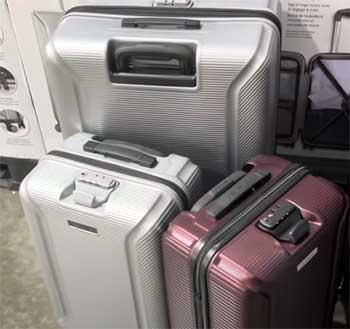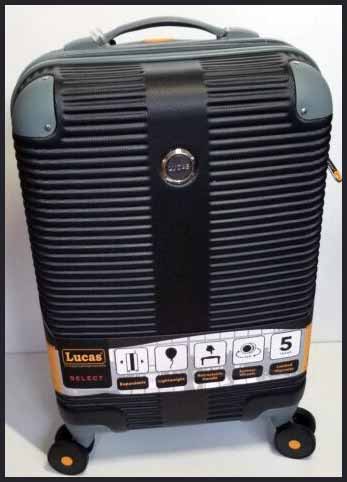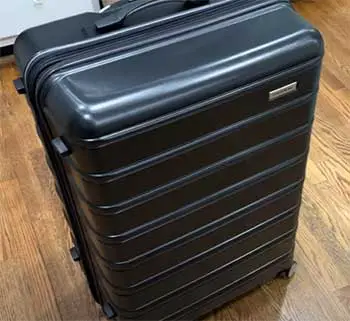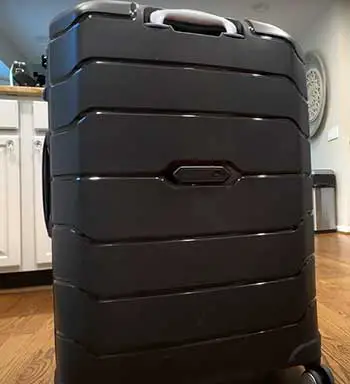I’m the type who overpacks—two pairs of shoes for a weekend? Guilty. So, when my old suitcase gave up, I faced a choice: Lucas Luggage or Samsonite. Both have their fans, and as someone who’s hauled bags through airports and over cobblestones, I wanted the real scoop.
In this article, I’ll share my journey comparing these two, breaking down their pros, cons, and key features in a way that’s like chatting with a friend. My aim? To help you pick the suitcase that’ll survive your next adventure—whether you’re team budget or team luxury.
Let’s roll!
A Brief Comparison Table
| Feature | Lucas Luggage | Samsonite Luggage |
| Price Range | $59 – $300 | $60 – $700 |
| Weight | Lightweight (e.g., 6-8 lbs for carry-ons) | Varies (e.g., 4.7-10 lbs for carry-ons) |
| Durability | Solid, lasts 3-5 years with moderate use | Premium, often lasts 5-10+ years |
| Warranty | 5 years | 3, 5, or 10 years (varies by model) |
| Materials | Synthetic PU wheels, polyester or hardside | Polycarbonate, aluminum, or polyester |
| Storage Capacity | Expandable, roomy | Spacious, some models less expandable |
| Wheels | 360-degree spinner wheels | Dual or 360-degree spinner wheels |
| Style | Functional, simple designs | Sleek, stylish, premium finishes |
| Best For | Budget travelers, regular use | Frequent flyers, luxury seekers |
Now that we’ve got the basics laid out, let’s unpack this suitcase showdown step by step.
Why I Started This Comparison?

Picture this: I’m at the airport, my old suitcase wobbling on a broken wheel, zipper straining against my overpacked clothes.
It was time for a change.
I’d heard good things about Lucas Luggage—affordable, lightweight, and reliable—and Samsonite, a name that’s been around forever, promising durability and style.
But I didn’t want to just pick one based on hype.
I wanted to test their claims against my real-world needs: a suitcase that’s easy to lug around, tough enough to handle baggage handlers, and won’t break the bank (or my back).
So, I rolled up my sleeves and started digging into what makes these two brands tick.
Lucas Luggage: My Take On The Underdog
First up, Lucas Luggage. I’ll admit, I didn’t know much about this brand at first. Founded in 1972, it’s not as flashy as some of the big names, but it’s carved out a reputation for practical, wallet-friendly gear.
My first impression? This is the suitcase for someone like me—someone who travels a few times a year and doesn’t want to spend a fortune.
- Pros of Lucas Luggage

Let me tell you, the lightweight factor is a game-changer.
I picked up a Lucas Ultra Lightweight 3-Piece Spinner Set, and the carry-on weighed in at just under 7 pounds.
Empty!
That’s a dream when you’re sprinting through a terminal or hoisting it into an overhead bin.
The 360-degree spinner wheels rolled smooth as butter on flat surfaces, which made navigating crowded airports a breeze.
I also loved the expandable feature—on a recent trip, I crammed in an extra pair of boots and still had room for souvenirs.
Price is another win.
Most Lucas pieces hover between $59 and $300, so I didn’t feel like I was signing away my savings. For a budget-conscious traveler, that’s huge. The durability surprised me too.
The synthetic PU wheels and sturdy polyester (or hardside options) held up to a couple of rough trips—no tears, no busted zippers. Lucas claims their stuff lasts 3-5 years with moderate use, and from what I’ve seen, that checks out.
The storage capacity? Generous. I’m talking multiple compartments and expandable sections that let me pack like a pro. And the 5-year warranty gave me some peace of mind—nothing fancy, but solid enough for the price.
- Cons of Lucas Luggage
Here’s where I hit some bumps. The design isn’t winning any fashion awards. It’s functional, sure, but it lacks the sleek, polished vibe I’d secretly hoped for. If you’re someone who likes their luggage to double as a style statement, Lucas might feel a bit basic.
Customer service was another sticking point. When I reached out with a question about a zipper, I got a quick response, but it wasn’t exactly warm and fuzzy—more like a scripted email.
Durability, while decent, isn’t top-tier. On a rocky train platform, I noticed some scuffs on the hardside version that made me wonder how it’d fare after a dozen trips. And the wheels?
Great on smooth floors, but they struggled a bit on uneven ground—think gravel or cobblestones. For short domestic jaunts, it’s fine, but I wouldn’t trust it for a rugged international adventure.
Samsonite Luggage: My Experience With The Big Name
Now, Samsonite. This brand’s been around since 1910, and it’s got a reputation that precedes it. I tested out a few models, including the Samsonite Freeform Hardside Carry-On and the Solyte DLX Softside Spinner, to see if the hype was worth it.
Spoiler: it’s a different beast from Lucas, and I’ve got plenty to say about it.
- Pros of Samsonite Luggage

Durability is where Samsonite shines. I threw the Freeform into the chaos of checked baggage on a cross-country flight, and it came out looking almost brand new.
The polycarbonate shell laughed off scratches, and the dual spinner wheels glided like they were on ice.
This thing feels built to last—some users swear by Samsonite bags that have survived a decade of heavy travel, and I believe it.
The style factor? Oh, it’s there.
The geometric design on the Freeform caught my eye at the baggage claim, and the color options (hello, Caribbean Blue!) made me feel a little fancy.
Functionality doesn’t take a backseat either.
The TSA-approved locks gave me confidence, and the interior compartments—like the wet pocket in the Solyte—kept my damp swimsuit from soaking everything else. Some models even have USB ports, which I used to charge my phone mid-flight. How cool is that?
Warranty options are a big plus too. Depending on the model, you’re looking at 3, 5, or 10 years of coverage. My Freeform came with a 10-year limited global warranty, which felt like a safety net for my investment.
And speaking of investment, while prices range from $60 to $700, you can snag deals on the lower end if you’re patient. For frequent flyers or business travelers, Samsonite feels like a partner you can rely on.
- Cons of Samsonite Luggage
But it’s not all sunshine and smooth wheels. The weight varies a lot—my Freeform was a featherlight 6.5 pounds, but other models tipped the scales closer to 10. That’s a dealbreaker if you’re trying to dodge airline fees or just hate lugging heavy bags.
Price is another hurdle. Sure, there are budget options, but the premium stuff—like the Proxis Spinner—can set you back hundreds. I winced when I saw the $500 price tag on some models, wondering if I really needed that much suitcase.
Storage capacity disappointed me in some cases. The Freeform, while roomy, didn’t expand as much as my Lucas bag, so I had to leave a sweater behind on one trip. And customer service?
It’s a mixed bag. When I called about a warranty question, I got stuck in a loop of automated menus before reaching a human—not the VIP treatment I’d expected from a premium brand.
The wheels, while stellar on flat terrain, weren’t invincible. On a gravelly path, they hesitated, reminding me that even Samsonite has limits. For all its strengths, it’s not perfect for every traveler—especially if you’re on a tight budget or packing for a month-long trek.
Key Features of Lucas Luggage And Samsonite Luggage
Let’s zoom in on what matters most when you’re picking a suitcase. I compared Lucas and Samsonite across a few key areas based on my hands-on time with both.
- Weight and Maneuverability

I’m obsessed with lightweight luggage—every pound counts when you’re racing to a gate.
Lucas wins here hands-down.
Most of their carry-ons clock in at 6-8 pounds, and I barely noticed the weight when I was rolling it around.
The spinner wheels spun freely on smooth floors, though they wobbled on rougher stuff.
Samsonite’s a bit of a wildcard.
The Freeform at 6.5 pounds felt like a dream, but heavier models dragged me down.
The dual spinners on premium Samsonite bags outshone Lucas on all surfaces, but you’re paying for that smoothness.
- Durability and Materials
Samsonite takes the crown for toughness. The polycarbonate and aluminum options shrugged off abuse like it was nothing—I even dropped the Freeform down a few stairs by accident, and it barely blinked. Lucas isn’t flimsy, though.
The polyester softsides and hardside shells held their own, but after a few trips, I could see wear creeping in. For a once-in-a-while traveler like me, Lucas is solid; for a road warrior, Samsonite’s the safer bet.
- Storage and Organization
I’m a sucker for extra space, and Lucas delivered. The expandable sections let me pack more than I probably should, and the compartments kept things tidy. Samsonite’s hit or miss—some models, like the Solyte, had clever pockets (wet pack, anyone?), but others felt restrictive.
If you’re an overpacker, Lucas might edge out Samsonite; if you prefer sleek organization, Samsonite’s got options that’ll make you happy.
- Price and Value
Here’s where I got practical. Lucas is the budget champ—$59 for a decent carry-on? Yes, please. I felt like I got more than I paid for. Samsonite’s pricier, no question. Even the affordable stuff starts at $60, and the high-end gear can feel like a splurge.
But the value’s there if you travel a lot—the longevity and features justify the cost over time. For a casual traveler, though, Lucas feels like the smarter buy.
- Warranty and Support
Warranties matter when your suitcase takes a beating. Lucas offers a straightforward 5 years—nothing flashy, but it’s there. Samsonite’s more generous with 3, 5, or 10-year options, depending on the model.
My Freeform’s 10-year warranty felt reassuring, but the customer service hiccups dulled the shine. Lucas’s support was basic but responsive—neither brand blew me away here.
A Tale of Two Trips
To really put these bags through their paces, I took them on separate trips. First, Lucas joined me on a weekend getaway to Seattle. Rainy streets, a packed ferry, and a bumpy bus ride tested its mettle.

The lightweight frame was a lifesaver when I had to carry it up stairs, and the expandable section swallowed my umbrella and a last-minute thrift store find.
The wheels struggled on wet cobblestones, but overall, it held up for the $80 I paid.
Then, Samsonite tagged along for a week-long work trip to Chicago.
O’Hare’s chaos was no match for the Freeform’s slick wheels, and the TSA lock kept my laptop safe.
I checked it on the return flight, and it emerged unscathed—impressive for a hardside.
The catch?
I couldn’t fit everything I wanted, and at $200, I expected a little more give.
Still, it felt like a pro-level companion.
- Who Should Choose Lucas?
After all this, I think Lucas is perfect for folks like me—casual travelers who want bang for their buck. If you’re hitting the road a few times a year, need something light, and don’t care about flashy designs, Lucas won’t let you down.
It’s the practical choice for domestic trips or short hauls where you’re not tossing it around too much.
- Who Should Choose Samsonite?
Samsonite’s my pick for the frequent flyers and big spenders. If you’re jetting off monthly, need a suitcase that’ll last a decade, or just love that premium feel, it’s worth the investment.
Business travelers and international adventurers will appreciate the durability and extras like USB ports or stylish shells. It’s built for the long haul—literally.
Frequently Asked Questions (FAQ)
Yes, it’s a solid choice—affordable, lightweight, and reliable for casual travelers like me. It’s not fancy, but it gets the job done.
Brands like Travelpro, Delsey, and American Tourister come close. They offer durability and features that rival Samsonite, often at different price points.
It’s subjective! Samsonite’s top-tier for durability, but Lucas wins on value. Your best bet depends on your travel style and budget.
Lucas isn’t tied to a flashy parent company like Samsonite (owned by Samsonite Corporation). It’s a standalone brand focused on practical gear.
Final Thoughts
So, where do I land? Honestly, it depends on you. Lucas won my heart for its affordability and lightweight ease—I’m not ready to drop $500 on luggage when $100 gets me something reliable. But Samsonite’s durability and polish left me tempted.
If I start traveling more, I might upgrade. For now, Lucas fits my life, but I can’t deny Samsonite’s appeal for those with bigger budgets and tougher trips.
You’ve got to ask yourself: What’s your priority? If it’s saving cash and keeping things light, go Lucas. If it’s longevity and a touch of luxury, Samsonite’s calling your name. Either way, you’re not stuck with a dud—both brands deliver, just in different ways.

